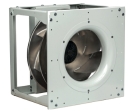EBM-papst fan units use centrifugal fans

EBM-papst’s RadiPac series of medium-pressure standalone centrifugal fans offers a self-contained and compact solution, removing the need for variable-speed drives and cost-intensive adjustments during commissioning. The motor and electronics are perfectly matched, so additional electronic filters, shielded cables or external motor protection are not needed.
RadiPac units are available with motor sizes up to 12 kW with impeller diameters from 250 to 1250 mm. Airflows up to 40 000 m3/h at pressures up to 1.8 kPa are possible. These units are primarily for the AHU market, but are flexible enough for many other applications.
There are three designs.
The Support Bracket version is for suspending on the unit wall and has pre-assembled inlet ring and plate. The shaft can be horizontal or vertical.
The Support Bracket + version has a pre-assembled inlet rig and plate. The fan can be decoupled from the environment by vibration elements. The shaft is horizontal.
The Cube has a pre-assembled inlet ring and full frame. The fan can be decoupled from the environment by vibration elements. The shaft can be horizontal or vertical. The Cube is not designed for suspending from the inlet plate!
The inlet ring guides air into the impeller and has a shape that increases the filling level of the impeller and reduces turbulence, enhancing its efficiency and reducing noise. The optimum position of the impeller is factory set.







